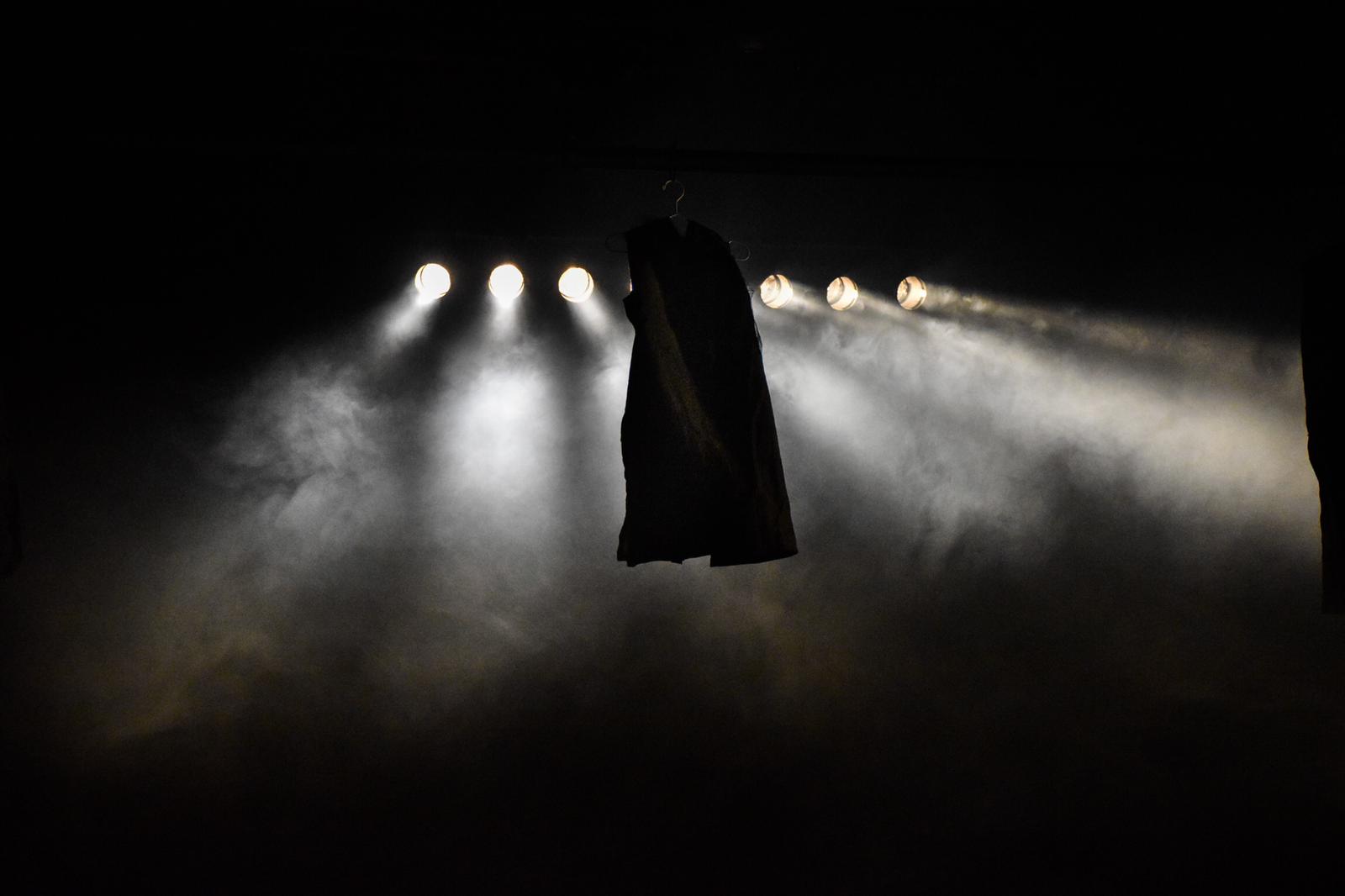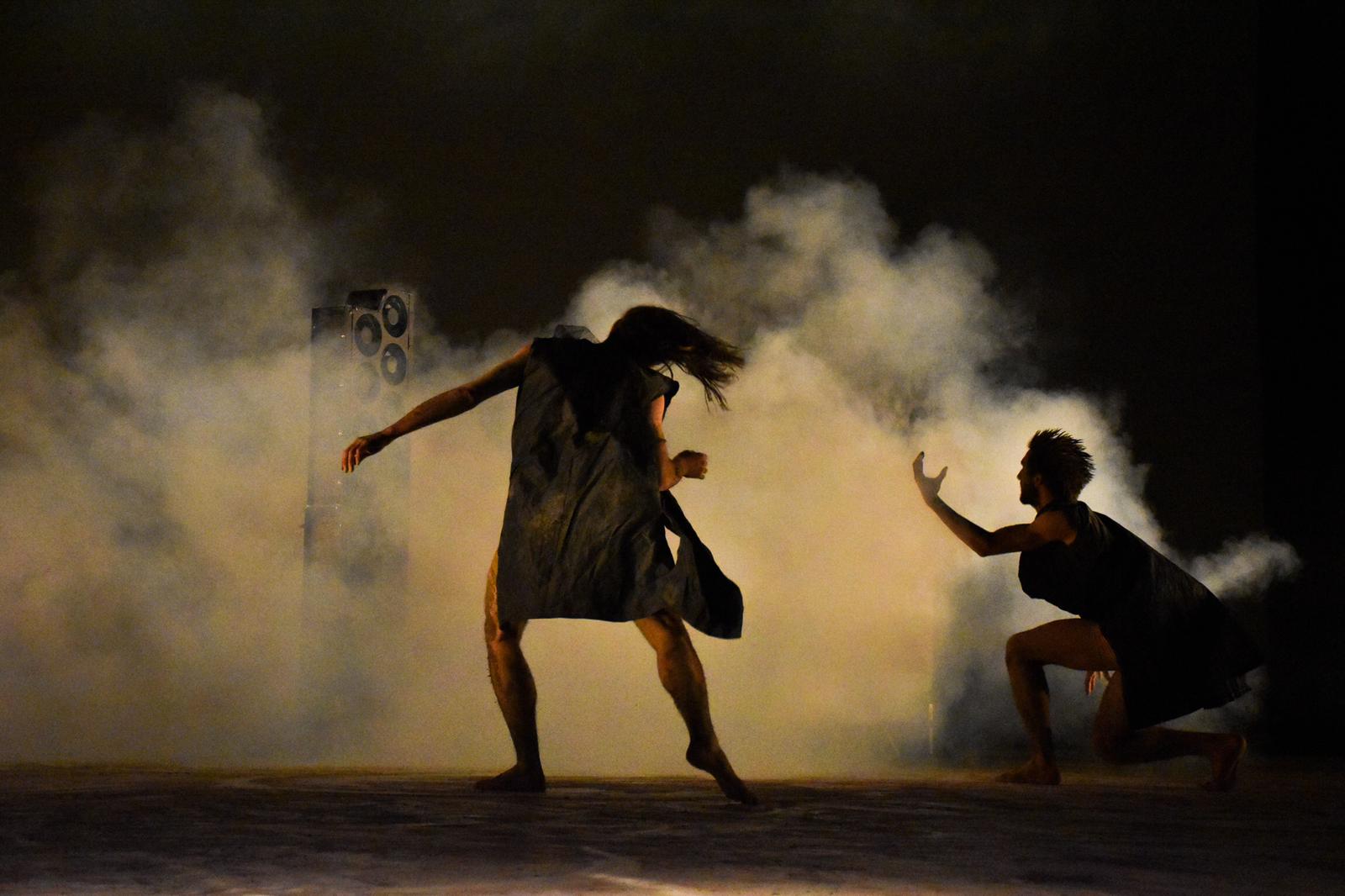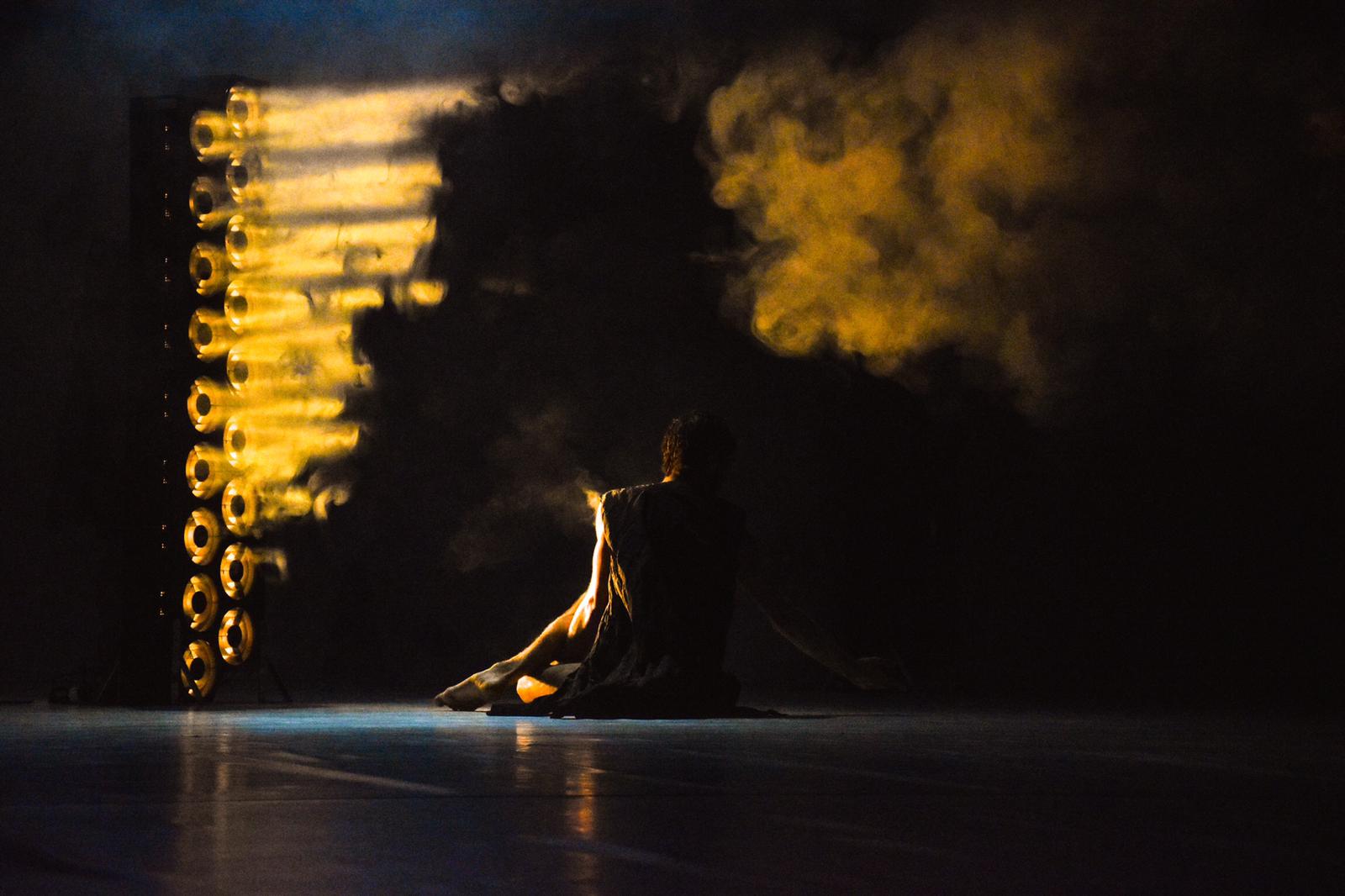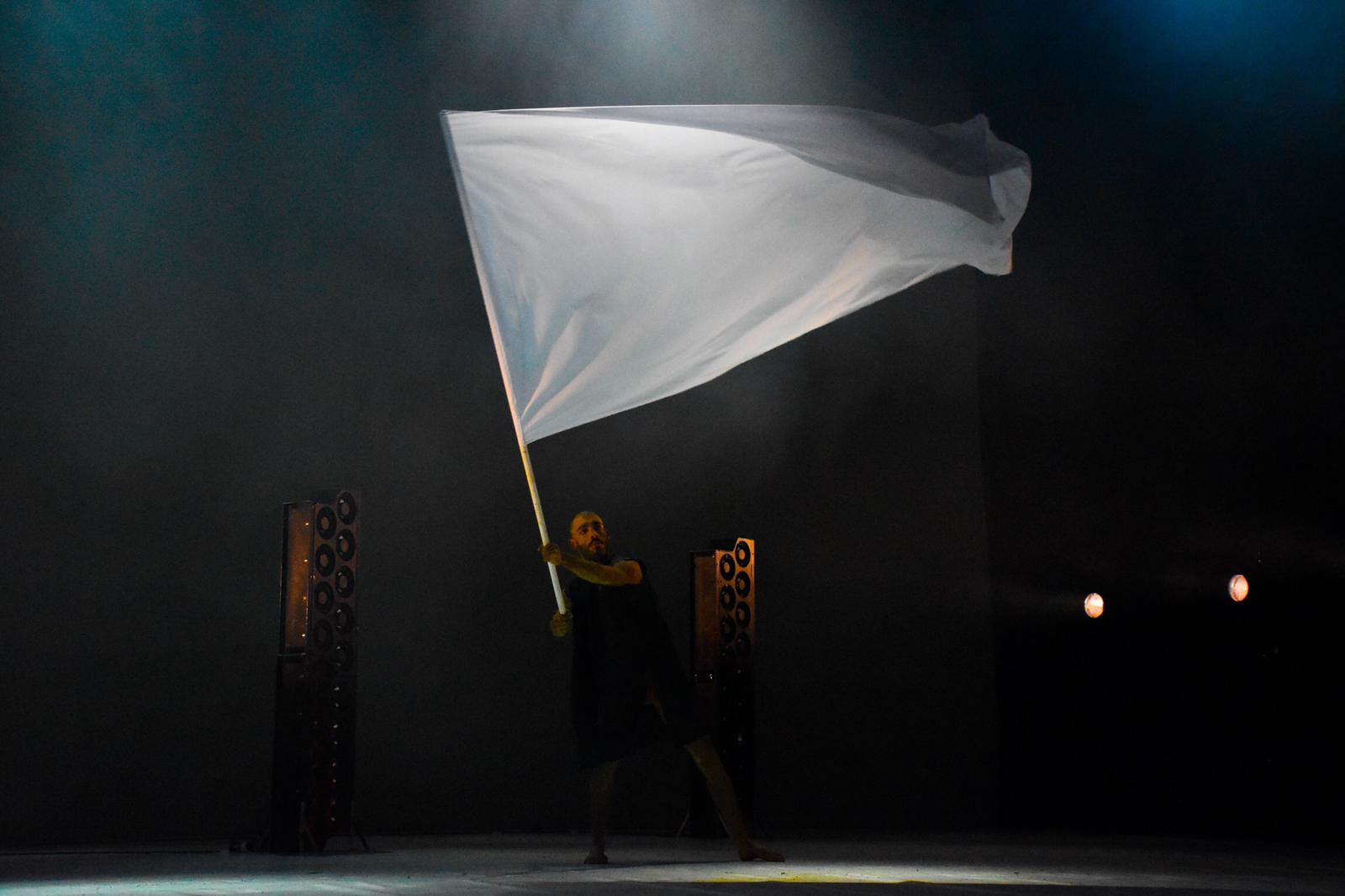
![]()
LALAI
Ausgegangen von einem traditionellen Lied – entstammt das Wort ‘Lalai’ aus dem persischen, welches kurzum oft in Schlafliedern verwendet wird. In Deutschland zu ergänzen mit ‘La La’. Fängt dieses Stück mit einem Schlaflied an – die Musik wurde von Ali Ostovar komponiert und gesungen von Hani Mojtahedy, die traditionelle Gitarre ‘Sehtar’ ist gespielt worden von Shahram Mohammedi. Begeben sich die Schicksalsgeister – Steve Alexandre Pedrosa Cardoso, Gabriel Gaudray Donnio, Harrison Gomes Dos Santos, Pierfrancesco Vicinanza, Tsung-Jui Yang, in eine schwere Reise. Ihre Körper voll bedeckt mit Erde.
Fünf junge Tänzer erforschen mit ihren Körpern ihre eingeschränkte Körpersprache. Alle haben eine andere Sprache und einen anderen Körper – andere Schicksale. Es entsteht durch die gleichen Emotionen im Kollektiv ein sogenanntes kollektives Genie, ein Gruppenorganismus, ohne dass alles perfekt zurechtgeschnitten ist. Der Ausdruck bzw. der Pathos steht im Vordergrund. Im Prozess erprobten die Performer und der Choreograf durch spielerische Aufgaben die Bewegungen zum Stück. Hierbei stach oft eine choreografische Absicht hervor, sich zwischen schnell, plötzlich und langsam, langgezogen zu bewegen.
Die massiven industriellen Lichterkulissen stehen im Kontrast mitten im Raum und können als reflektierende Spiegel, oder drei Särge gesehen werden. Immer wieder tauchen starke und schwache Symbole auf, wie zum Beispiel die weiße Flagge, oder eben der berühmte Apfel. Lalai ist teils greifbar und doch wiederum ungreifbar, sie versuchen Dialoge durch Bewegungen zu erschaffen, aber diese sind abstrakt und werden im Ausdruck missverstanden oder anders interpretiert.
Dieses Tanzstück ist basierend auf und ist inspiriert von der Arbeit von Ali (Alireza) Ostovar und seiner Musikkomposition „Lalai“.
Das Stück wurde für einen Tanzabend an der Folkwang Universität der Künste entwickelt und zählt als Bestandteil einer Prüfungsverordnung des Bachelorprogramms.
Künstlerische Leitung und Choreografie: Hakan Sonakalan
Assistenz: Francesca Pavesio
Choreografische Mitarbeit und Tanz: Steve Alexandre Pedrosa Cardoso, Gabriel Gaudray Donnio, Harrison Gomes Dos Santos, Pierfrancesco Vicinanza, Tsung-Jui Yang
Musik: Lalai von Ali Ostovar | Homepage: aliostovar.com
[Poem: Traditionell Persisches Schlaflied]
Vokal: Hani Mojtahedy
Sehtar: Shahram Mohammedi
Licht: Oliver Semrau
Kostüm: Anne Bentgens
Dauer: ca. 18 Min.
Genre: Tanz, Choreografie, Performance

Dance: Gabriel Gaudray Donnio, Pierfrancesco Vicinanza | Photo: Ko-Yun Liao

Dance: Pierfrancesco Vicinanza | Photo: Ko-Yun Liao

Dance: Steve Alexandre Pedrosa Cardoso | Photo: Ko-Yun Liao
![]()
LALAI
Based on a traditional song – the word ‘Lalai’ comes from the Persian, which in short is often used in lullabies. In Germany to be completed with ‘La La’. This piece begins with a lullaby – the music was composed by Ali Ostovar and sung by Hani Mojtahedy, the traditional guitar ‘Sehtar’ was played by Shahram Mohammedi. The spirits of fate – Steve Alexandre Pedrosa Cardoso, Gabriel Gaudray Donnio, Harrison Gomes Dos Santos, Pierfrancesco Vicinanza, Tsung-Jui Yang – embark on a difficult journey. Their bodies covered with earth.
Five young dancers use their bodies to explore their limited body language. All have a different language and a different body – different destinies. The same emotions collectively create a so-called collective genius, a group organism, without everything being perfectly tailored. The expression or the pathos is in the foreground. During the process, the performers and the choreographer tried out the movements for the piece through playful tasks. A choreographic intention to move between fast, sudden and slow, drawn out often stood out.
The massive industrial light backdrops contrast in the middle of the room and can be seen as reflecting mirrors, or three coffins. Strong and weak symbols appear again and again, such as the white flag or the famous apple. Lalai is partly tangible and yet intangible, they try to create dialogue through movements, but these are abstract and in expression are misunderstood or interpreted differently.
This dance performance is based on and inspired by the work of Ali (Alireza) Ostovar and his music composition “Lalai”.
This piece was developed for a dance evening at the Folkwang University of the Arts. And counts as part of an examination regulation of the bachelor’s program.
Artistic direction and choreography: Hakan Sonakalan
Assistant: Francesca Pavesio
Choreographic collaboration and dance: Steve Alexandre Pedrosa Cardoso, Gabriel Gaudray Donnio, Harrison Gomes Dos Santos, Pierfrancesco Vicinanza, Tsung-Jui Yang
Music: Lalai by Ali Ostovar | Homepage: aliostovar.com
[Poem: Traditional Persian Lullaby]
Vocal: Hani Mojtahedy
Sehtar: Shahram Mohammedi
Light: Oliver Semrau
Costume: Anne Bentgens
Duration: approx. 18 min.
Genre: dance, choreography, performance
Produktion:
